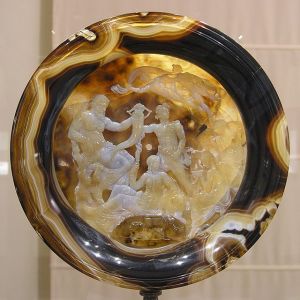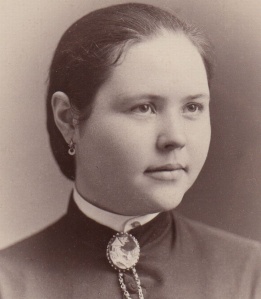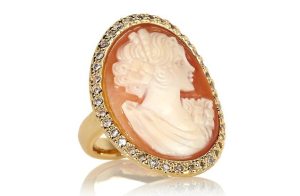Some of my favorite pieces of jewelry in my ‘collection’ are the few cameo pieces I own. I don’t know what attracts me to them. Is it their vintage, old fashioned appearance? Or the uniqueness of the pieces? Let’s first discuss what a cameo is.
A cameo as carving into an item or jewel, the vessel being made in the same manner. It can either be of vintage quality or contemporary. Almost always, the cameo displays a (positive) relief image that contrasts with an intaglio, which is made of a negative image. Originally, and still in discussing historical work, cameo only referred to works where the relief image was of a contrasting colour to the background; this was achieved by carefully carving a piece of material with a flat plane where two contrasting colours met, removing all the first colour except for the image to leave a contrasting background.
Today, cameo may be referred to pieces that do not have a contrasting color and the cameo head is replaced by other images in the oval frame, like animals or flowers, etc.
Ancient and Renaissance cameos were made from semi-precious gemstones, especially the various types of onyx and agate, and any other stones
![The Portland Vase is an Illyrian cameo glass vase, which is dated to between AD 1 and AD 25, though low BC dates have some scholarly support.[1] It is the best known piece of Illyrian cameo glass and has served as an inspiration to many glass and porcelain makers from about the beginning of the 18th century onwards. It is first recorded in Rome in 1600-1601, and since 1810 has been in the British Museum in London. It was bought by the museum in 1945 (GR 1945,0927.1) and is normally on display in Room 70.](https://backwaterprimer.files.wordpress.com/2014/10/portland-vase.jpg?w=198&h=300)
Modern cameos are produced by putting a silhouette. such as a portrait, on top of a contrasting background color. Glass and shell make up the cheaper and more modern pieces.
A modern cameo is made by setting a carved relief, generally a portrait, onto the background of a contrasting color.
The traditional method of carving the cameo directly of a material with integral layers or banding can be used. The banding is made out agate or layered glass, which have different layers with colors. Sometimes dyes are even use to enhance the colors.
Sir Wallis Budge states the noun “Cameo” apparently comes from Kame’o. Kame’o is a kabbalistic slang word that means “magical square”, or a talisman where magic spells are carved.
Though often worn as jewelry, cameos were also worn as signet rings and large earrings. The largest example of this would have been way to big to wear as such and were just admired as objects d’art. As far back as 3rd century B.C., stone cameos of great artistry were made in Greece.

The oldest remaining major Hellenistic piece surviving is the Farnese Cup. Not only were they very popular in Rome, but also in the family circle of Augustus.
The technique of making the cameo this way enjoyed some revival during the early Renaissance period, as well as the 18th and 19th centuries.
Napoleon supported glyptic arts, which began the neoclassical revival in France. Even his coronation crown was decorated with cameos. How lovely!
During King George III’s reign in Britain, along with his granddaughter, Queen Victoria, together they began to be major promoters of the cameo trend and they began mass-produced by the second half of the 19th century.

Classically, the images depicted on a cameo were usually scenes of Greek or Roman mythology or portraits of rulers or important dignitaries. These cameo portraits were often gifts from royalty to their subjects. Surviving antique cameos, some of them are over 2000 years old, are either in private collections or displayed in museums.
Many modern cameos have many layers of agate carved into them. The layers are then dyed to create a strong casting color. Most popular colors are white on red-brown, white on blue, and white on black to create two-layer stones. The artist creates translucent layers so the shading of the background can come through. This way, a very life-like quality can come about.



Other types of cameos are shell cameos, Ultrasonic machine carved cameos, and hand-worked portrait cameos.
One type of cameo that I think it absolutely lovely is the antique Wedgewood cameos. Josia Wedgewood, a potter, created Wedgewood Cameos in the 1700s. Josia Wedgewood created this unique blue color of the cameos, is called jasper wear. These cameos are unique in which no other cameos in the world look like them because of their jasperwear and the portrait figures crisp, clean and with distinct lines. There is no mistaken these Wedgewoods for any others. Wedgewood cameos come in a few main colors like white, pink, green, blue, and black. The styles they come in are pendants, rings, bracelets, and brooches. To see if you have a real Wedgewood Cameo, it will be marked in the rear WEDGEWOOD MADE IN ENGLAND. Here are some examples:
I love cameos because of their vintage look, their connection to the past,they go with anything, and how feminine they look any way you wear them. They are just a great piece of timeless jewelry that would be a great gift and to pass on from generation to generation. Your Grandma would agree too! 🙂
These are my cameos. I don’t care much for the green one because of discoloration on the back of it, so I hardly wear it. I just bought the little heart one off of Ebay last week.
A great source to get even more information on cameos in general and to purchase authentic cameos, like the Wedgewood Cameos I have shown you here, I highly recommend checking out Cameo Jewelry( http://www.cameojewelry.com/index.php) Not only do they tons of information, but tons of lovely cameos for sale, a newsletter you can sign up for, and I see they also have an affiliate program. I want to try to get in on that.
These opinions are 100% my own. I am NOT currently affiliated with Cameo Jewelry. I wrote this post because of my burning passion for cameos 🙂
I hope you have enjoyed this post. If you did, please click ‘like’ below and if you haven’t already, I invite you to suscribe.
Till next time….Cheers! Have a wonderful weekend, my dear readers!










